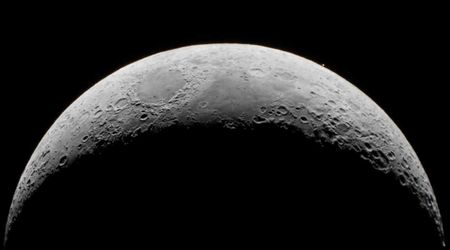What color is the moon


Everyone knows that the Moon is mostly gray. Every time you look at a picture of the Moon or look at it in the sky, you may be familiar with its very monotonous shades of grey. In fact, the surface of the Moon seems to be deprived of all the different colors that we are used to seeing every day on our planet.
However, if you look closer, there may be a few other different shades up there. And this is because different minerals on the Moon's surface reflect different colors.
Why is the Moon grey?
Well, it’s mainly due to the fact that the moon surface is made of the following basic minerals:
- Magnesium,
- Iron,
- Calcium,
- Silicon,
- Feldspar,
- Pyroxene.
Curiously, the common point of all these minerals is that, in the form of dust, they are all grey. The other thing is that, like all moons and planets, our moon doesn't emit its own light... Moon light comes from the reflection of the light coming from the sun.
Fortunately for us, there are now different shades of grey involved, which makes the Moon's appearance a little less boring. The Moon's surface bears many scars due to the constant bombardment of small meteorites, but also older marks due to its violent formation. This is what those dark patches (of any shape and size) are on the surface of the moon!
Why does the moon seem to change color in the sky?
There are a few factors that can influence how we can interpret the color of the moon:
- The location of the observer (is it heavily polluted?).
- The position of the Sun and Moon (low on the horizon or high in the sky?).
- The sensitivity of the observer's eye can also filter what he perceives (remember that famous blue/gold dress that went viral on social media?).
This can lead people to see the Moon in different colors.
Why is the moon red?
Once the moon has reached a total eclipse, it will appear red to observers on Earth and not black. This is because some of the residual sunlight from our planet's atmosphere is scattered towards it. This phenomenon is also known as "Blood Moon".
Why is the moon blue?
The blue moon is very rare (hence the famous saying) because it usually requires an enormous amount of dust and smoke in the air. So the moon does not literally change colour, it is simply all the particles in the air that make the moon appear blue in the night sky. This usually happens after forest fires or volcanic eruptions.
Why is the moon orange?
This apparent colour change usually occurs when the moon is very low on the horizon. Any light emitted by a celestial object that is too low on the horizon will have to pass through much more of the atmosphere to reach you than if it were just above your head in the sky. This means that the light passes through many more particles, gases and pollution, which explains the orange/yellowish glow.

The Orange Moon

The Blue Moon

The Pink Moon
The impact of sunlight angle on the moon's brightness and hue
The angle at which sunlight hits the moon can have a significant effect on its perceived color. When the sunlight hits the moon at a low angle, it has to pass through more of the Earth's atmosphere before it reaches the moon. This allows the shorter blue wavelengths of light to be scattered more, leaving the longer red wavelengths to reach the moon and make it appear reddish or orange.
On the other hand, when the sunlight hits the moon at a higher angle, it passes through less of the Earth's atmosphere. This allows more of the shorter blue wavelengths of light to reach the moon, making it appear brighter and more white or bluish in color.
Sunlight angle is one of the main factors that contribute to the various atmospheric effects that influence the moon's perceived color.
So what is the true color of the moon?
In orbit around the moon since 2009, the LROC (Lunar Reconnaissance Orbiter Camera) has been taking high-resolution images of the moon for more than a decade now. Some of the close-up images have been processed to differentiate the different materials on the moon's surface, revealing subtle shades of dark blue and dark red, as shown in the photo below.

Credits: LROC
Let's talk about Albedo
An albedo is a unit of measurement for the reflectivity of a surface. At 0%, the object is perfectly black and does not reflect anything. At 100%, it reflects all the light received. An object is considered "white" above 80%.
Earth has an average albedo of 35%.
And the Moon? Our celestial companion has an average albedo of only 8%, like... coal. So, according to this unit of measurement, the moon is almost black...
Conclusion
It seems that the colours of the moon are not just limited to white and grey, and the state of the atmosphere above you can have a great influence on what you can observe. There seems to be a greater variety of colors below the surface of the moon, although we will only be sure of this once mankind sets foot on the moon again.
In the meantime, you can still look upon most nights and admire the moon in all of its (colourful) beauty.









